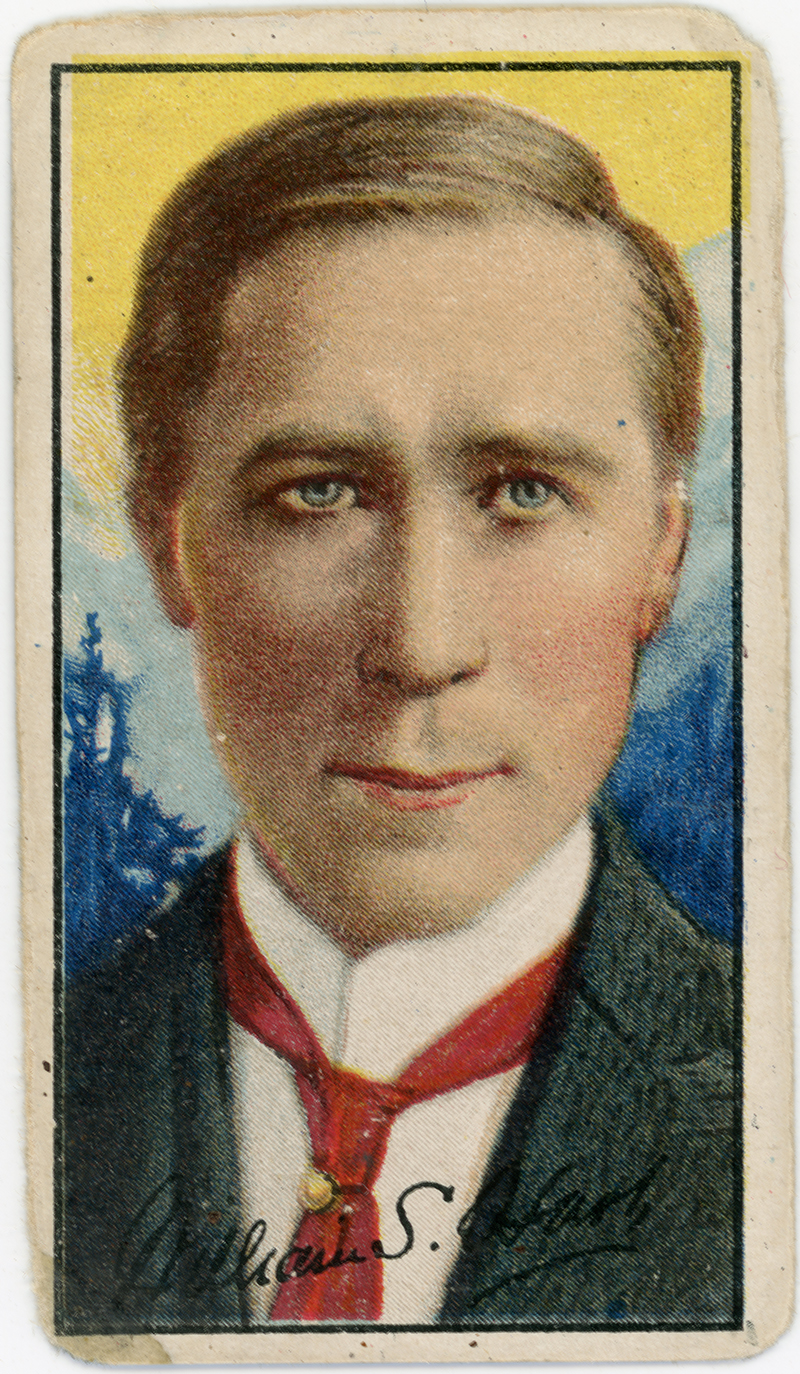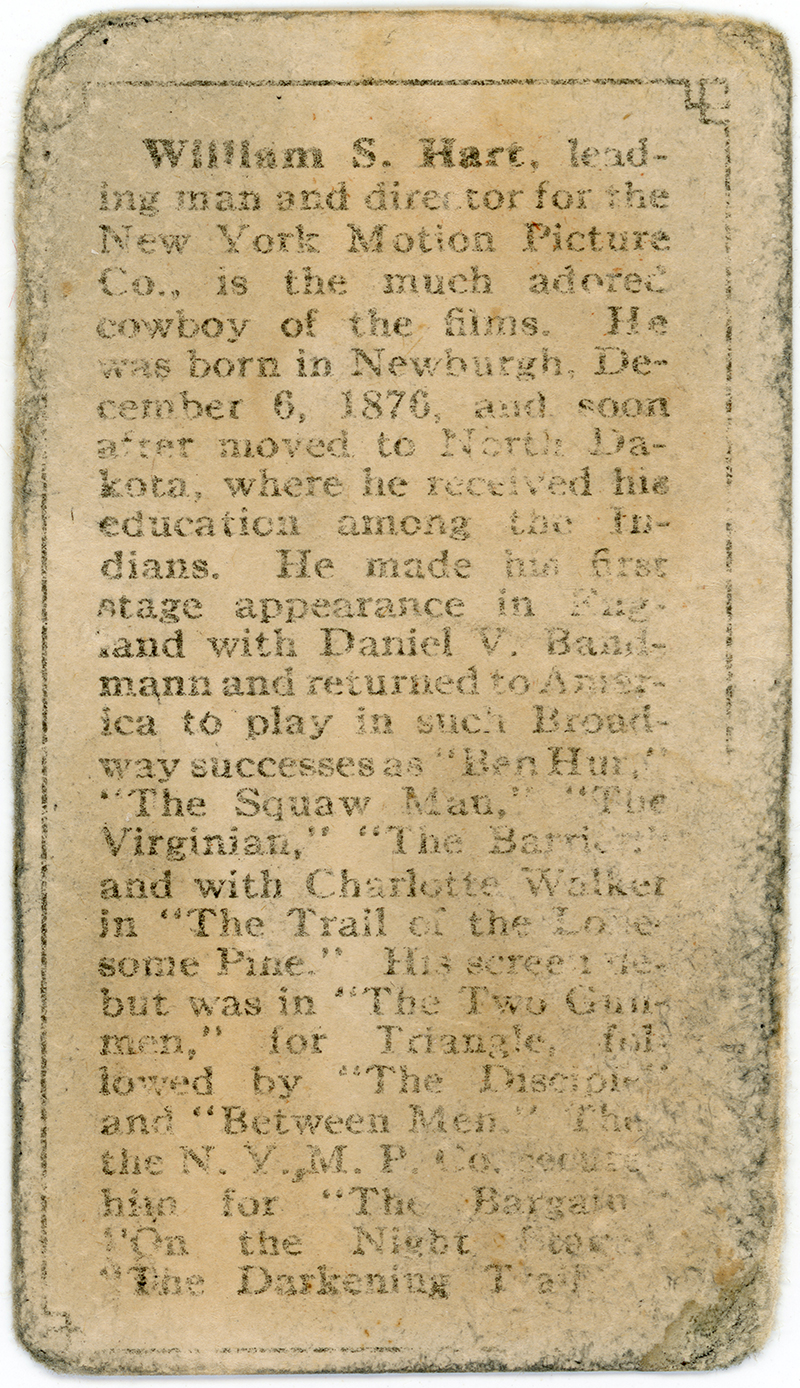|
|
|
William S. Hart: Imperial Tobacco Co. Movie Star Card, Canada 1916. One in a series (Series C93) of 50 cards depicting modern movie stars. Comparable to the U.S. series T82, issued 1915-1920. (Like later bubble gum cards, tobacco cards came in packs of cigarettes and were collected.) Back of card reads:
William S. Hart, leading man and director for the New York Motion Picture Co., is the
much adored cowboy of the films. He was born in Newburgh, December 6, 1876 [sic], and soon after
moved to North Dakota, where he received his education among the Indians. He made his first
stage appearance in England with Daniel V. Bandmann and returned to America to play in such
Broadway successes as "Ben Hur," "The Squaw Man," "The Virginian,"
"The Barrier," and with Charlotte Walker in "The Trail of the Lonesome Pine."
His screen debut was in "The Two Gunmen," for Triangle, followed by "The
Disciple" and "Between Men." Then the N.Y.M.P.Co. secured him for "The
Bargain," "On the Night Stage," "The Darkening Trail."
Hart was indeed born Dec. 6 in Newburgh, N.Y., but not in 1876. He was born in 1864. It's not a typographical error. There is speculation that either the studios or Hart himself, or both, wanted the public to think he was younger (and thus more viril?) than he was. Hart was known as "the two-gun man," but he didn't appear in a film by that name (or "The Two Gunmen"). As for the rest of the films mentioned, they're all out of order with the release dates. Hart appeared in many pictures for NYMPC, but "The Disciple" was nowhere near the second. It was more like the 24th. "The Bargain" was released about 9 months earlier, not later. The New York Motion Picture Co. was formed in 1909 as a film distribution outlet by Adam Kessel, Charles Baumann and Frank Balshofer. But this was the era of block booking; the all-powerful studios had a lock on film distribution, so NYMPC's planned business model wasn't going to work. In the spirit of "If you can't beat them, join them," NYMPC almost immediately transformed into a production company. Over the next 12 years, it would release films under the brand names 101 Bison, Kay-Bee, Broncho, Domino, Reliance and Keystone Studios. It entered (and exited) joint ventures and mergers with various other production and distribution companies, most notably Mutual Film Corp. While with Mutual, Kessel and Bauman formed Keystone, which not only had Charlie Chaplin under contract in 1913-14 but also became a partner in the new, Culver City-based Triangle Film Corp. in July 1915 (after which time William S. Hart vehicles were released under the Triangle name). A major partner in Triangle was Jesse Lasky's Feature Play company, which merged into Famous Players, which became Paramount Pictures — which would become the Justice Department's sacrificial lamb when the federal government and ultimately the U.S. Supreme Court put an end to block booking many years later on grounds the practice created an unlawful monopoly. And so we come full circle. The third image in this sequence is a different example of the same card, owned by a third party. It is presented here only for legibility.
LW2857: 9600 dpi jpegs from original tobacco card purchased 2017 by Leon Worden.
|
1910s
1910s
1910s
~1915
Photoplay Cover 1916
Canadian Tobacco Card 1916
3/4 Body 1910s
Pre-1919
Color Strip 1919
Color Strip ~1919
Sheet Music: "I Want a Cave Man" 1919
1910s-1920s
Paramount 1910s-1920s
Australian Pinback 1910s/1920s
Arcade Card ~1920
~1920
O'Malley/Mounted 1921
Hart-Fritz 1920s
1920s
1920s
France 1920s
Germany 1920s
Spain 1920s
Spain 1920s
English Tobacco Card 1921
German Tobacco Card w/ Maurice Chevalier ~1920s
France 1920s
France 1920s
1920s
Cine-Mundial, Spain 1922
Tobacco Card
South Africa 1922
Flagg's KisselKar 1924
~1925
Shriners 1925
With Chief Standing Bear 1926
Arcade Card ~1926
4-Up Arcade Card 1928
Arcade Cards 1920s x2
|
The site owner makes no assertions as to ownership of any original copyrights to digitized images. However, these images are intended for Personal or Research use only. Any other kind of use, including but not limited to commercial or scholarly publication in any medium or format, public exhibition, or use online or in a web site, may be subject to additional restrictions including but not limited to the copyrights held by parties other than the site owner. USERS ARE SOLELY RESPONSIBLE for determining the existence of such rights and for obtaining any permissions and/or paying associated fees necessary for the proposed use.








































